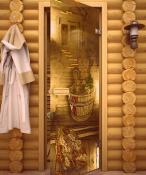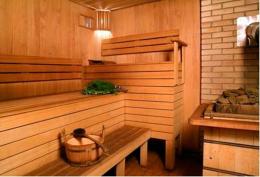Search
Login
Russian bath, decoration materials for the bath
Russian bath is a source of health and longevity. But this saying is true only if the steam room was finished with natural materials, namely regular wood.
Content
Types of baths
Three types of baths were widely known, mainly: russian steam bath, Finnish sauna, Turkish hammam.
These types differ from each other not only in appearance, but, first of all, in temperature and humidity conditions.
Turkish baths have the lowest temperature (40 * -60 * C) and the highest relative humidity, it approaches 100%. The low heating temperature allows the use of stone and ceramics in the decoration, since at this temperature there is no danger of burns.
In contrast to Turkish baths, Finnish saunas can be attributed.
Finnish saunas are the hottest and driest, the temperature here is 100 * -120 * C, and the relative humidity does not reach 10%.
The golden middle is the Russian bath. Temperature in russian bath, with proper heating, is about 60 * C, and relative humidity 40%.
Finnish and Russian baths are united by a common approach to the premises: as a rule, they consist of a steam room, a washing room and a relaxation room.
There are different layout options, but modern saunas have tiled, plastic panels and various modern materials.
The rest room is finished at their discretion, usually they wall the walls with a pine lining. Depending on the purpose of the bath, and very often this is the place where the birthday is celebrated, a rather large space is planned and made out. In addition to the relaxation room, they equip a beautiful open veranda. If there is a pool nearby, this is an additional, festive holiday destination.
The most specific requirements, of course, apply to the steam room.
Due to the high temperature in the Russian steam bath, of course, and the Finnish sauna, the finishing materials must be safe, in terms of heating, to prevent thermal burns of the sweater.
What are baths made of?
The material of the building depends on the location of the bathhouse - and it can be inside a residential building or a separate building.
From time immemorial, Russian baths were built as a separate building.
Of course, first of all, in this way they protected the houses from fire, because the bathhouse is the fire that heated the room. But in the old days, and in principle, even now, a fire is a huge misfortune.
In our climatic conditions, you cannot live in a hut.
The most popular bathhouse is wooden, as the tree retains heat well, environmentally and beautifully. When heated, the tree releases phytancides, creates a pleasant aroma, thereby creating a unique microclimate in the room.
Bath erected from a log, and it can be a manual cutting or rounded, and from a beam.
The beam can be solid, solid or glued. Modern new technologies create glued beams that have minimal moisture. A glued beam bath practically does not shrink, unlike a chopped bath.
A chopped bathhouse is built in at least two runs, after laying the log house, he is given time to shrink, and this is a rather long period, and only after that they continue construction.
A bath of glued beams is finished immediately after installation.
During construction, experts advise using lumber winter felling and large section.
The thickness of the beam should be at least 10 cm, logs - 17 cm.
The fact is that the beam has the same thickness from the bottom to the top, and the logs when installing the log house have corner elements, and the thickness of these crowns requires a reduction in the log, and significant, there are cold bridges in the places of the crown.
When warming a Russian bath, during the construction of timber and logs, they use the same materials as for warming residential buildings, namely: tow, felt, linen, moss, etc.
Modern construction allows the use of flexible acrylic sealants.
Outside, tree protect from the effects of precipitation using impregnation. Sometimes the tree is painted, sheathed.
In addition to wooden baths, capital bricks are built of brick and only silicate brick is unsuitable for this construction.
In construction, there are baths made of gas - and foam concrete.
Naturally, the fire resistance of such baths is much higher, but like wooden structures, such baths must have good thermal insulation, waterproofing and vapor barrier, otherwise fungi and mold may appear on the inner surface.
Types of wood
During the construction of a Russian bath, it is possible to use a variety of types of wood.
Since olden times, when there wasn’t such an extensive range of lumber as now, built of local wood.
They tried to make the lower crowns of oak, the floor was laid out of it.
Aspen was widely used as a tree resistant to decay.
When decorating the bath, linden was widely used, especially when decorating the steam room, since it does not emit tar, it is slightly heated and exudes a useful aroma.
At the same time, it should be noted the fragility of the linden, in order to extend its durability, after contact with water, the linden must be well dried.
In modern construction of Russian baths, coniferous lumber was widely used, more popular and affordable: pine, spruce, cedar.
The best lumber is a winter forest, it is denser, has less humidity, fewer cracks, it retains heat better.
Larch is an exclusive among lumber, it does not rot, does not turn blue, it is not eaten by insects, it contains medicinal bio-substances, it does not need to be treated with protective compounds, it is close to oak in durability and it keeps heat 30% higher than pine. But this exclusive is very expensive.
When building a Russian bath, use only a well-dried tree, since the raw coniferous tree will flow with resin for the first few years, this can lead to a burn of a person and other negatives.
To prevent such troubles, the steam room is sheathed with a well-dried clapboard of hardwood.
Steam room decoration
As noted above, the interior of the bathhouse, and specifically the steam room, must be trimmed with wood.
Several unsuccessful attempts were made to replace wood with concrete, metal and synthetics. But such an innovation did not bring good results, the person did not receive any recovery.
Walls should have low thermal conductivity, not crack, do not emit harmful substances.
Once again we repeat that the best quality timber is winter felling, growing in the north.
Hardwood is better suited for finishing a steam room, as it is less cracked and warped, so the inside of the bath is sheathed with a lining made of different materials.
Lime wall paneling fits very well, but it is quite expensive.
Cheaper is alder and aspen lining.
The cheapest lining made of birch, it exudes a good aroma, but has one drawback - it turns black and rots very quickly.
Very good in the construction of baths teak, thuja, Canadian cedar and Abashi. Abashi wood - the exotic wood of Africa - has a porous structure and the shelves from it practically do not heat up.





